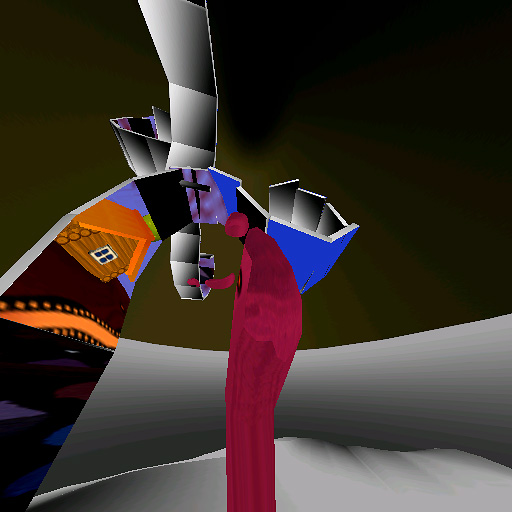|
3DVisA Resources
3DVisA Index of 3D Projects: Digital Arts
Rutopia 2 by Daria Tsoupikova
Daria Tsoupikova is an Assistant Professor in the School of Art and Design and Electronic Visualization Laboratory (EVL) at the University of Illinois at Chicago (UIC).
Her research area and artwork include development of virtual reality (VR) art projects, networked multi-user exhibitions and educational multimedia. Current VR research,
publications and artwork explore the relationship between the aesthetics of virtual environments and traditional arts and the effect of VR aesthetics on the user's
perceptions and emotions.
A virtual reality art project Rutopia 2, is a follow up to Rutopia. It explores the relationship between aesthetics of virtual art, painting and
Russian folk arts, such as wood sculpture, traditional toys, and decorative painting. The project depicts a magic garden with interactive sculptural trees
that connect to distant worlds and unites them into a shared network community. The tree structures combine Russian folkloric forms with futuristic designs while being
based on a singular module - a rectangular screen. The animation of these dynamic tiled trees strives to break through the static flatness of the contemporary
tiled-display grids, architectural façades, and surfaces into the perpetually changing 3D sculptural forms.

Fig. 1. Rutopia 2 by Daria Tsoupikova, 2006. © Daria Tsoupikova. Reproduced with kind permission.
The trees are the prototypes of the interdisciplinary public portals that combine architectural, tele-immersive, educational and artistic ideas with social functionality into a communal hybrid. Their organic movements embodied
through mathematical calculations and interpolations depend on the user's interaction with the environment and his or her proximity to the trees.
The garden explores the interactive symbiosis between man, nature and technology, and visualises an unattainable world of harmony inspired by folk utopian idealism and
futuristic design.
Rutopia 2 was created using Ygdrasil (YG) framework, developed as a tool for creating networked virtual
environments. It is focused on building the behaviours of virtual objects from re-usable components, and on sharing the state of an
environment through a distributed scene graph mechanism. It is being used in the construction of artistic and educational applications.
Rutopia 2 is designed for the exhibition on the C-Wall VR system. The C-Wall is a high-quality, tracked, circularly polarised passive stereo wall for VR
projection. A participant in the C-Wall presentation can interact with the project and navigate in the environment. The user's position in the virtual world is tracked
from the glasses and wand trackers. When a person navigates and interacts with the virtual environment, messages are sent to the system and information is then
streamed back into the C-Wall in real-time. The project was built using Ygdrasil advanced rendering techniques, Bergen spatial sound server, OpenGL Performer 3.2
and the CAVE library. It runs on an Intel Linux PC running SUSE 10.0 and connected to an Ascension Flock of Birds tracker.

Fig. 2. Rutopia 2 by Daria Tsoupikova, 2006. © Daria Tsoupikova. Reproduced with kind permission.
The user is tracked from the stereo glasses and hand Wand tracker. Participants control the direction of the movement and interaction with the objects by using
only a wand interface and no buttons. The windows of the trees were made using the new Ygdrasil node stencilBuffer. This node acts as a mask covering the areas
outside the windows so that only the selected window area allows a view to the other world. The storyboard sketches were first hand-painted using gouache and watercolour.
They set up the colour palette, composition and virtual space layout and served as reference for the development of the scene graph. The 3D models were built using
3D Paint tool in the Maya software. The details of the decorative ornamentation were painted inside the 3D scene and then exported as models with textures.
Other textures were individually painted, scanned, and applied on the 3D objects.
Project date: 2005-2007
Further details, the artist's contact details, more still images and a movie are available from the project webpages,
Rutopia 2, hosted by
the Electronic Visualization Laboratory (EVL), School of Art and Design, University of Illinois at Chicago.
Tsoupikova, D. (2008), 'Rutopia 2. Development of a Virtual Reality Artwork', 3DVisA Bulletin,
March.
Record compiled by Anna Bentkowska-Kafel, 11 September 2006. Updated by Daria Tsoupikova, 17 April 2007. Last updated 15 January 2008.
3DVisA gratefully acknowledges the help of Daria Tsoupikova with preparation of this record.
© Daria Tsoupikova and 3DVisA, 2006.
Back to the list of 3D projects
|
